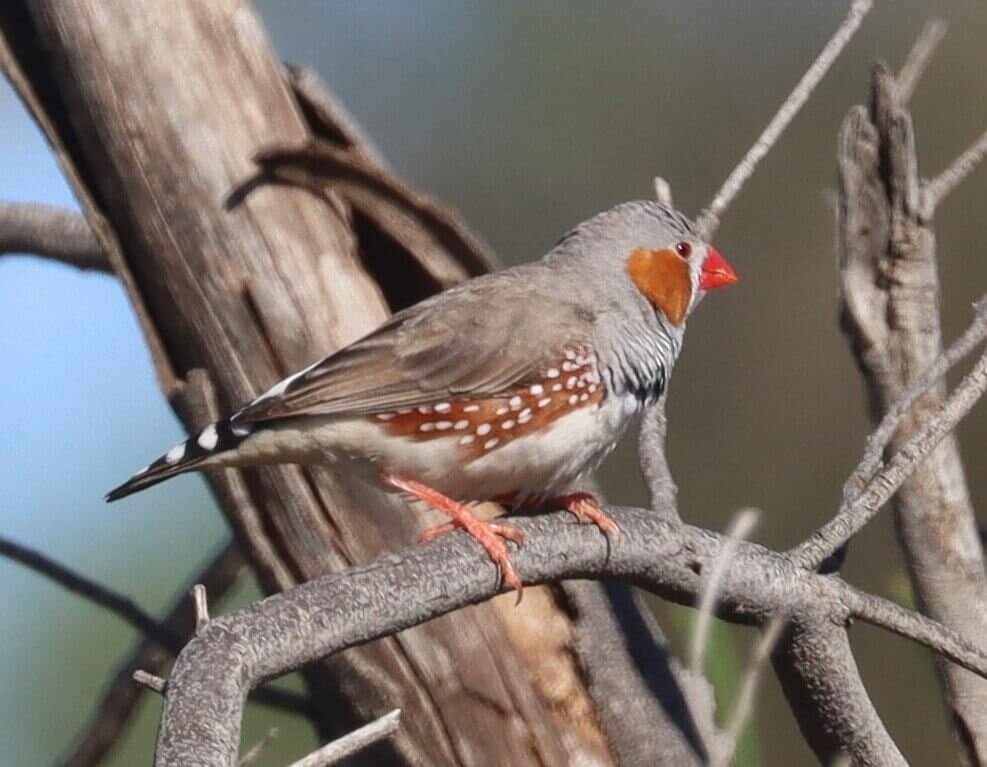Zebra Finches and Porcupine Grass
The Zebra Finches are here on Raakajlim in numbers, meaning that the Porcupine Grass (Triodia scariosa) seed is ripe. The Finches are one of my favorite birds, with their distinctive cheeping, painted faces and beautifully spotted plumage. But they do demolish the seed from the Porcupine Grass when it is ripe!
We collect a bit of Porcupine Grass seed each year, because it is a bit of an enigma. Despite the Triodia hummock grasslands being widespread across arid and semi-arid Australia, covering about one-third of the interior, the plants themselves are very difficult to propagate for revegetation. Quite a lot of research has gone into trying to understand seeding and recruitment of the various Triodia species.
Firstly … Germination of Triodia is triggered by fire. When undertaking revegetation, this means that use of smoke water is generally required to improve germination rates. More recently, physiological dormancy of the seed has been identified (1). The solution? Laborious removal of the seed husk (floret structure). Ughhh, have you seen how small these seeds are? Tricky, but not insurmountable. Next …
Another problem … species of Triodia exhibit mast seeding. This means that the plants produce large and synchronised seed crops, but only in some years. They flower every year but in most years, there is no seed set and the flowerheads are empty. That makes it tricky to collect seed when you want it.
Research (2,3) has correlated the mast seeding events with high rainfall in the previous twelve months. Mast seeding is also considered predictive of years when there is a high fire danger. That makes sense I guess, good rainfall, high fuel loads, increased likelihood of fire, which is what Triodia needs to regenerate. But why produce so much seed? Well, mast seeding has the effect of alternately starving and satiating the seed predators. It’s a bit cruel really. In years where there is no seed set, the seed predators don’t have enough to eat and they starve. Then, in masting years, the seed predators are low in numbers and there’s so much seed around that they can’t eat it all. That way there is enough seed for mass recruitment of Triodia to grow into new plants.
But not on Raakajlim! We have a large patch of Porcupine Grass growing near the orange orchard next door. Our neighbour kindly waters this with overspray from the irrigation sprinklers. Under these modified conditions, the Porcupine Grass produces seed every year which is great for our seed collecting, and great for the Zebra Finch and lots of other critters too. Hooray!
More information
Ecological niche and bet-hedging strategies for Triodia (R.Br.) seed germination https://academic.oup.com/aob/article/121/2/367/4779922
Proximate causes and possible adaptive functions of mast seeding and barren flower shows in spinifex grasses (Triodia spp.) in arid regions of Australia: https://www.publish.csiro.au/rj/rj13104#:~:text=Mast%20seeding%2C%20the%20intermittent%20production,from%20arid%20regions%20of%20Australia.
Fire timing in relation to masting: an important determinant of post-fire recruitment success for the obligate-seeding arid zone soft spinifex (Triodia pungens) https://www.ncbi.nlm.nih.gov/pmc/articles/PMC5786211/
The most famous mast seeding ecological cascade is the oak tree. In mast years the huge number of acorns provide ample food for mice. Mice increase in abundance, and so do the ticks which live on them. But the black-legged ticks carry a tick borne pathogen called Lyme Disease which causes serious illness in humans. Shorthand, stay out of the forests after an oak mast seeding event. https://www.caryinstitute.org/news-insights/podcast/acorns-and-lyme-disease
First published December 2nd 2020









